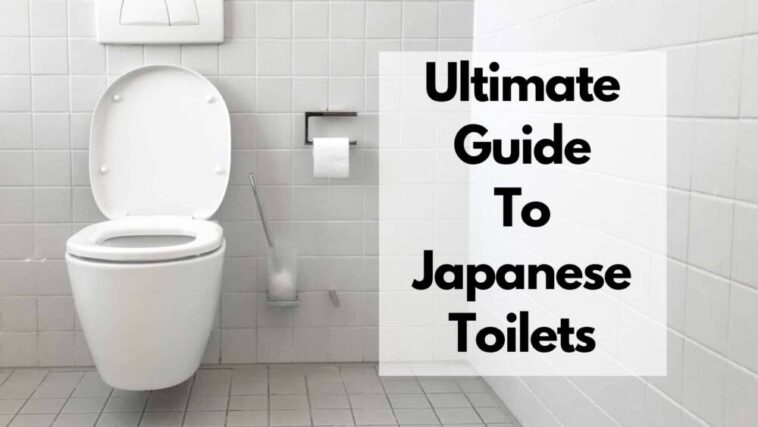If you are going to Japan, you better get schooled on how to use a Japanese toilet. If you think you are going to just wing it, believe me, you won’t! My friends already had a share of their problems.
The Japanese take the whole toilet routine very seriously and you will notice they have several buttons, symbols, functions, and whatnot. This even goes for Japanese washing machines. So if you don’t know how to use one, better take a quick crash course on that as well before going to Japan!
If you are considering taking Japanese lessons just to understand how to use a Japanese toilet, worry not, cos this article should help you decipher all of that.
Since you have the basics decided, let’s move on to how to use a Japanese toilet, step by step:
Page Contents
How To Use A Japanese Toilet?
- Step 1: Where do you go?

Okay, so you first need to know where to go. Called “toire” in Japanese, toilets can be found in most public spaces including convenience stores. Look for the 様式 symbol, which stands for Western toilet.
- Step 2: Disinfect:
Covid or no Covid, the Japanese believe in disinfecting the toilet seats before they use it. And that is such a good habit, don’t you think so?
Most modern and urban Japanese cities have a disinfectant dispenser installed. Simply fold up a few sheets of toilet paper, spray the disinfectant on it and wipe your toilet seat before you plonk yourself there.
- Step 3: Warm your bum:
If you live in a country where winters get so cold that you dread placing your bum on the freezing toilet seat, you will thank the Japanese for having that covered. Japanese toilet seats are warmed, giving you some real pleasuring and comfortable pooping times. Now, that does not mean that you can settle down there with a mag while there is a line-up outside!
- Step 4: Start The Sound Simulator
I was serious when I said the Japanese have you covered. Sometimes, when answering nature’s call, it can make unpleasant noises that can be quite embarrassing. Look for the “音” symbol that makes the flushing noise even when you are not flushing. That covers up all the grunts and other noises, saving you from going red in the face!
However, if that gets a bit annoying, you can always turn it off by pressing the stop button.
- Step 5: FLUSH
Can you imagine the panic and dread that can spread through your heart and stomach when you finish and can’t figure out which button flushes the toilet? Don’t worry. The flush button, like most western toilets, is usually behind on the wall.
If there is nothing there, look on the side for a small panel. While most urban toilets are fitted with sensors and will flush automatically, there are quite a few across the country that require to be flushed manually.
Like most western toilets, Japanese toilet flushes also give you the option of going half flush to save water or full flush. Look for these symbols: 小 for the water saving flush and 大 for the full flush. You might even find a flush that is activated by a sensor. Simply wave in front of it to flush away everything.
- Step 6: Wash, don’t wipe:
Well, you can wipe if you want but do give the good old bidet a try before you rule it out altogether. And doctors across the world are recommending going the Japanese way, saying it is more hygienic. Just saying.
Japanese bidets come with a power-saving feature as well in many newer toilets. They wash in warm water, so you don’t freeze your bum off in the winter.
But even the bidet comes with different spots that you can target, like the front and the back. Look for the おしり (called oshiri) symbol if you’ve finished and you want your bum washed clean.
Specially designed for women, the ビデ (called bidet) symbol gives the front a cleansing. Sometimes you don’t want the pressure and just want a gentle cleansing with some warm water. In this case, use the button with the やわらか (called yawaraka) symbol.
It doesn’t stop there, though. A lot of Japanese toilets also come with additional functions where you can control the pressure of the water, and the direction the bidet is pointing in, to get a more accurate cleaning (I told you this is serious business).
Look for the 水勢 (called suisei) to control the pressure of the water hitting you. If it does not feel positioned quite right, you can use the button that has the 位置 symbol (called ichi) to adjust the position.
Now how do you control these? Look for the arrow symbols to navigate these. Kinda like playing a video game. This symbol – 低 stands for “low”, while this one 高 stands for high. If you want it weaker, choose this 弱 symbol and this one 強 for a stronger jet.
Now the real question. How do you stop? Or say you hit the wrong button and don’t like the way it feels. Simply hit the “Stop” button, which goes by this symbol – 止, and you’re done.
- Step 7: Wipe afterward:
The Japanese also use toilet paper as much as the West, though it is only to pat dry after you wash with the bidet. So if you absolutely don’t want to give the bidet a try, you do have the option of wiping.
However, if you like the bidet, go ahead and tear off a few sheets of toilet paper to dry yourself, and drop the used paper directly inside the toilet bowl. As mentioned earlier, toilet paper is also used to wipe down the toilet seat with a disinfectant before you start.
Just remember to drop it only inside the bowl and not in the trash can. You can throw the rest of the garbage in the small trash can inside every toilet cubicle.
- Step 8: Squatting toilet:
While most developed Japanese cities have sitting-down, western-style toilets, there are still some villages and towns in Japan that use the squatting toilet.
Scientifically, this is healthier for you cos you get to exercise your thigh muscles, but for a first-timer, it can be a bit intimidating. It’s not that hard, all you need to do is, squat and do your job. Just make sure you face away from the door and towards the toilet.
These toilets may have a flush that is on the floor or on the wall. Just like you would do for the western toilets, look around for a lever or the symbol to flush the toilet.
Some extras that are good to know before you go:
Emergency buttons in Japanese Toilet:
Usually found in the disabled toilets, but these days found in every single toilet to help the disabled or anybody in the case of an emergency. The emergency call button is placed next to the flush panel, so it can get a bit confusing.
It is good to know that this exists so that you don’t press the wrong button if you simply want to flush. So, stay away from the 非常 symbol, unless you really get sick and you need help from a uniformed person rushing to your rescue.
And no, not understanding which symbol stands for “flush” or how to use the bidet is not considered an emergency.
- Bathroom slippers:
In the West, bathroom slippers are referred to as any slippers that are generally worn at home, but the Japanese use the bathroom slippers ONLY in the toilet and bathroom to avoid spreading infection around the house. Be very careful about using these inside the toilet and NEVER step out with these.
Why are Japanese toilets so complicated?
Japanese toilets are actually quite fun and a real experience. They have so many features that you will end up spending more time than necessary, just trying out each of these features. But, this is what makes them complicated as well. You need to first figure out what each and every symbol means and how you can use the button.
Difference between Western toilets and Japanese Toilets
The two toilets don’t look any different. We are so used to the toilet paper system with western toilets and frankly, everything is just so straightforward – you poop, wipe, flush and you’re out of there. Japanese toilets also kinda have you do the same stuff but with some additional steps.
Also, instead of wiping, you wash. Before you scrunch your face, let me assure you, washing is much healthier than wiping. Learn from the Japanese!
How to find out where the Japanese toilet is?
This is the most important, in my opinion. If you don’t know where the toilet is, the rest of the article is pointless, isn’t it? Use the words “toirewa doko desuka?” to ask where the toilet is.
Next, you need to walk into the toilet meant for your gender. To save you the embarrassment of walking in on the other sex, look at these symbols carefully:
“男” stands for men, while the “女” symbol stands for women.
But, most toilets will have a male and a female icon to save you the trouble.
What do the buttons on a Japanese toilet do?
Japanese toilets often come equipped with a variety of buttons that offer a range of functions to enhance the user’s comfort and cleanliness.
The buttons typically have kanji characters and symbols to indicate their respective functions.
Here are some common buttons you might find on a Japanese toilet along with their explanations:
- 大 (Big) / 小 (Small): These buttons control the water flush volume. 大 (大きい, “ookii”) refers to a larger flush, while 小 (小さい, “chiisai”) indicates a smaller flush.
- おしり (Oshiri) / ビデ (Bide): These buttons activate the bidet function for cleaning the posterior. おしり (お尻) means “buttocks,” and ビデ (derived from “bidet”) refers to the bidet spray.
- フェミニン (Feminine): This button is used for a gentler and more focused bidet spray, primarily for feminine hygiene.
- ノズル (Nozzle) Position: This button adjusts the position of the bidet spray nozzle to customize its aim.
- 洗浄 (Senjou) / クリーン (Clean): These buttons start the cleansing process using the bidet spray.
- 乾燥 (Kansou) / ドライ (Dry): After using the bidet, this button activates the warm air dryer to dry the cleaned area.
- パワフル (Powerful): This button increases the pressure of the bidet spray for a more thorough cleaning.
- シャワー (Shower): This button activates a shower mode, which can be used for cleaning the toilet itself.
- オート (Auto): This button triggers an automated cleaning sequence that includes bidet, air drying, and flushing.
- セーブ (Save) / 節水 (Sessui): These buttons are used to activate a water-saving flush mode, using less water for flushing.
- レディース (Ladies): This button may activate additional bidet functions specifically designed for women.
- メモリ (Memory): This button allows users to save their preferred bidet settings for future use.
Do you need to wipe with Japanese toilet?
Using a Japanese toilet with bidet functions can greatly reduce the need for extensive wiping after using the restroom. The bidet feature in Japanese toilets provides a gentle water spray for cleansing, which can effectively clean the area.
Many people find that using the bidet helps them feel cleaner and fresher compared to using toilet paper alone.
However, the level of wiping required can still vary based on personal preference and the effectiveness of the bidet function.
Some users may choose to use a small amount of toilet paper to pat dry after using the bidet, while others might opt to use toilet paper for a final wipe. Ultimately, it depends on the individual’s comfort and habits.
Which way do you flush a Japanese toilet?
To flush a Japanese toilet, you would typically find a lever or button located on or near the toilet tank. This lever or button is used to initiate the flushing process.
If it’s a lever, you would push it downward or lift it upward, depending on the design of the toilet. If it’s a button, you would press it to activate the flush.
The flushing mechanism might have different kanji characters or symbols indicating “big” and “small” flush options, as mentioned in the previous response.
The kanji characters for “big” (大) and “small” (小) are often used to indicate the flush options. “大” represents a larger, more powerful flush, while “小” represents a smaller flush that uses less water. The choice between the two flush options depends on the amount of waste in the toilet bowl.
How does a traditional Japanese toilet work?
A traditional Japanese toilet, often referred to as a “squat toilet” or “Asian-style toilet,” is quite different from the Western-style sit-down toilets that are more common in many parts of the world.
Traditional Japanese toilets have been used for centuries and are still found in some older establishments or rural areas. Here’s how they work:
- Basic Design: A traditional Japanese toilet consists of a ceramic or porcelain basin set into the floor. The basin is typically flush with the ground and has a small built-in platform or footrests on either side. There might be a hole or drain at the center of the basin.
- Squatting Position: To use a traditional Japanese toilet, the user needs to squat over the basin with their feet on either side of the hole or drain. The footrests provide stability and support while squatting.
- Usage and Flushing: Users should position themselves over the hole and squat down to eliminate waste directly into the basin. After use, some traditional Japanese toilets have a water source nearby (such as a scoop or bucket of water) that you can use to manually flush away the waste.
- Cleaning: Many traditional Japanese toilets do not have toilet paper provided. Instead, you might find a small water scoop or spray device for cleaning yourself after using the toilet. This cleaning method is a precursor to the modern bidet functions found in contemporary Japanese toilets.
- Hygiene and Etiquette: Proper hygiene and cleanliness are essential when using traditional Japanese toilets. Users are expected to clean up after themselves using the provided water and cleaning tools.
It’s important to note that traditional Japanese toilets can be unfamiliar to those not accustomed to using them. They require a different posture and technique compared to sit-down toilets.
However, many public places and modern establishments in Japan have transitioned to Western-style toilets due to their convenience and familiarity.
In recent years, Japanese society has largely shifted towards Western-style toilets equipped with bidet functions, heated seats, and other modern amenities. These toilets are now the norm in urban areas and are designed to provide a high level of comfort and cleanliness.
Are Japanese toilets hygienic?
Yes, Japanese toilets are generally considered to be highly hygienic and technologically advanced. The modern Japanese toilet, often equipped with bidet functions and other features, focuses on providing a high level of cleanliness and comfort for users.
Here are some reasons why Japanese toilets are considered hygienic:
- Bidet Functions
Many Japanese toilets are equipped with bidet functions that use a gentle water spray to clean the user after using the toilet.
This helps ensure thorough cleansing and reduces the need for excessive wiping with toilet paper, which can contribute to better hygiene.
- Adjustable Settings
Users can adjust the water pressure, temperature, and nozzle position of the bidet spray to suit their preferences, ensuring a comfortable and effective cleaning experience.
- Heated Seats
Some Japanese toilets have heated seats, which can be especially pleasant during colder months. A warm seat enhances comfort and prevents the shock of sitting on a cold surface.
- Air Drying
Many modern Japanese toilets come with built-in warm air dryers. After using the bidet, users can activate the dryer to gently dry themselves, reducing the need for toilet paper and promoting better hygiene.
- Antibacterial Surfaces
Some Japanese toilets feature antibacterial coatings on the toilet seat and other surfaces, which helps prevent the growth of harmful bacteria and contributes to a more sanitary environment.
- Touchless Operation
Some advanced Japanese toilets offer touchless operation for features like flushing, reducing the potential for cross-contamination through physical contact.
- Automatic Flushing
Many Japanese toilets have sensors that automatically flush the toilet after use, promoting cleanliness and reducing the need for manual flushing.
- Regular Maintenance
Public restrooms and establishments in Japan often place a strong emphasis on cleanliness and sanitation. Cleaning and maintenance routines are typically thorough and frequent, further contributing to the hygienic environment.
Are Japanese toilets automatic?
Yes, many modern Japanese toilets are equipped with automatic features that enhance user convenience and hygiene. These automatic functions are designed to provide a more comfortable and efficient restroom experience. Here are some of the automatic features commonly found in Japanese toilets:
- Automatic Flushing: Many Japanese toilets have sensors that detect when the user has finished using the toilet. After the user stands up, the toilet automatically flushes, promoting hygiene and eliminating the need for manual flushing.
- Bidet Functions: Bidet features in Japanese toilets are often automatic. They include adjustable water pressure, temperature, and nozzle position, and they activate with the press of a button. After use, the bidet may automatically retract the nozzle and even initiate air drying.
- Heated Seats: Japanese toilets with heated seats often have temperature sensors that automatically adjust the seat’s warmth based on the ambient temperature or user preferences.
- Lid Opening and Closing: Some advanced Japanese toilets have sensors that open and close the toilet lid automatically when a user approaches or leaves, reducing the need for manual lid manipulation.
- Air Deodorizers: Certain Japanese toilets are equipped with air deodorizers that automatically release pleasant scents or neutralize odors after use.
- Motion-Activated Controls: Touchless operation is a common feature in Japanese toilets. Users can activate flushing, bidet functions, and other features through motion sensors, minimizing physical contact with the toilet’s surfaces
- Self-Cleaning Nozzles: Some bidet-equipped Japanese toilets have self-cleaning nozzles that sanitize themselves before and after each use, ensuring hygiene and cleanliness.
- Automatic Seat Cleaning: In some models, the toilet seat itself can be automatically sanitized or cleaned after each use.
What is a must wear inside the toilet in Japan?
In Japan, it’s common etiquette to wear the provided slippers or indoor shoes when using the toilet in certain establishments. These slippers are usually provided outside the restroom area and are meant to be worn specifically within the restroom space. The practice is aimed at maintaining cleanliness and hygiene by preventing outdoor footwear from coming into contact with the restroom area.
What is unique about Japanese toilets?
Japanese toilets are known for their unique and advanced features that prioritize user comfort, hygiene, and innovation. Here are some of the distinctive aspects that set Japanese toilets apart:
- Bidet Functions: One of the most well-known features of Japanese toilets is their bidet functions. These functions include adjustable water pressure, temperature, and nozzle positions for a customized and thorough cleaning experience.
- Heated Seats: Many Japanese toilets come with heated seats, providing warmth and comfort, especially during colder months.
- Air Dryers: After using the bidet, air dryers can be activated to gently dry the user, reducing the need for toilet paper and promoting better hygiene.
- Self-Cleaning Nozzles: Some models have self-cleaning bidet nozzles that sanitize themselves before and after each use.
- Automatic Flushing: Japanese toilets often have sensors that automatically flush the toilet after use, minimizing the need for manual flushing and promoting hygiene.
- Lid Opening and Closing: Some advanced models have sensors that automatically open and close the toilet lid when a user approaches or leaves.
- Deodorizing Features: Certain Japanese toilets are equipped with air deodorizers that help neutralize odors.
- Touchless Controls: Many toilets have motion-activated controls, allowing users to flush and operate bidet functions without touching any buttons or handles.
- Sound-Masking Features: To provide privacy and reduce embarrassment, some Japanese toilets are equipped with sound-masking features that play background noise or music while the toilet is in use.
- Antibacterial Surfaces: Some toilets have antibacterial coatings on surfaces, promoting a more sanitary environment.
- Water-Saving Options: Japanese toilets often have water-saving flush options to promote environmental sustainability.
- Elderly and Disabled Features: Some toilets are designed with features that cater to the needs of the elderly and people with disabilities, including higher seats, handrails, and other accessibility aids.
- Integration of Technology: Japanese toilets continue to integrate technology, such as smartphone apps that allow users to control various functions remotely.
Can Japanese toilets play music?
Yes, some Japanese toilets are equipped with features that allow them to play music or sound effects. This feature is often referred to as “sound masking” or “sound privacy.”
The purpose of playing music in the restroom is to mask any potentially embarrassing sounds that might be produced during toilet use. It’s designed to provide a level of privacy and comfort for the user.
Here’s how the music-playing feature works in certain Japanese toilets:
- Sound Options: When using the toilet, you can activate the sound-masking feature by pressing a button on the control panel. This might be labeled as “音楽” (ongaku), which means “music,” or “音” (oto), which means “sound.”
- Music Selection: Some toilets offer a selection of different tunes or sounds that you can choose from. These can include nature sounds, classical music, traditional Japanese melodies, or even white noise.
- Volume Control: You can adjust the volume of the music to your preference. The sound is intended to be gentle and soothing rather than loud.
- Privacy: The purpose of the music is to provide a level of privacy by covering up any sounds that might be considered embarrassing. The masking effect of the music helps users feel more comfortable using the restroom in public or shared spaces.
Do Japanese toilets need electricity?
Yes, many modern Japanese toilets do require electricity to power their advanced features and functions. These features include bidet functions, heated seats, air dryers, sound-masking capabilities, automatic flushing, and more. The inclusion of these electronic features enhances user comfort, hygiene, and overall restroom experience.
Also Read:
- Visiting Tokyo? Don’t miss out the Sumo Match! Here’s how to get the tickets!
- Moving to Tokyo? Here’s how you can rent an apartment there!
- How to Adopt in Japan





